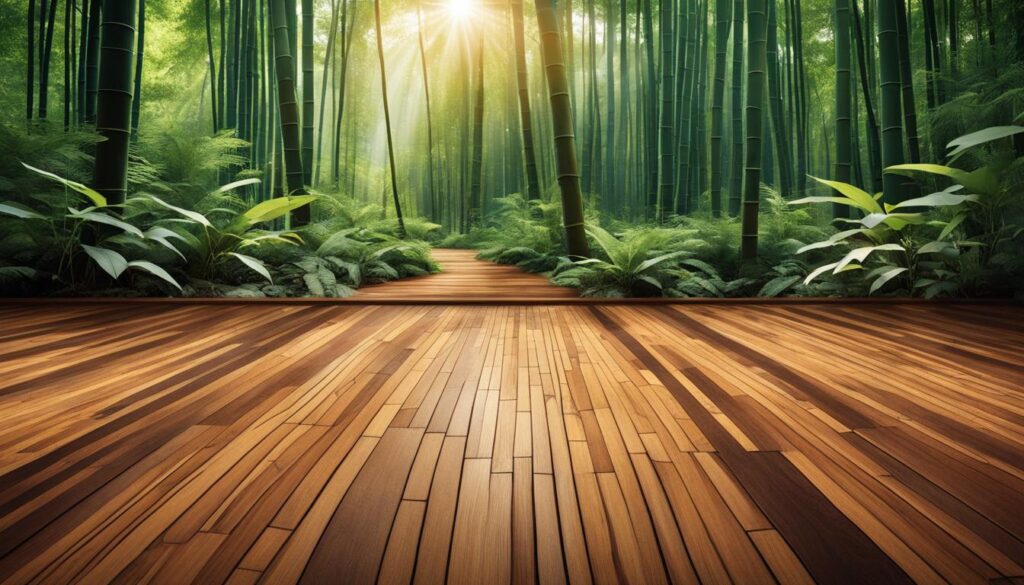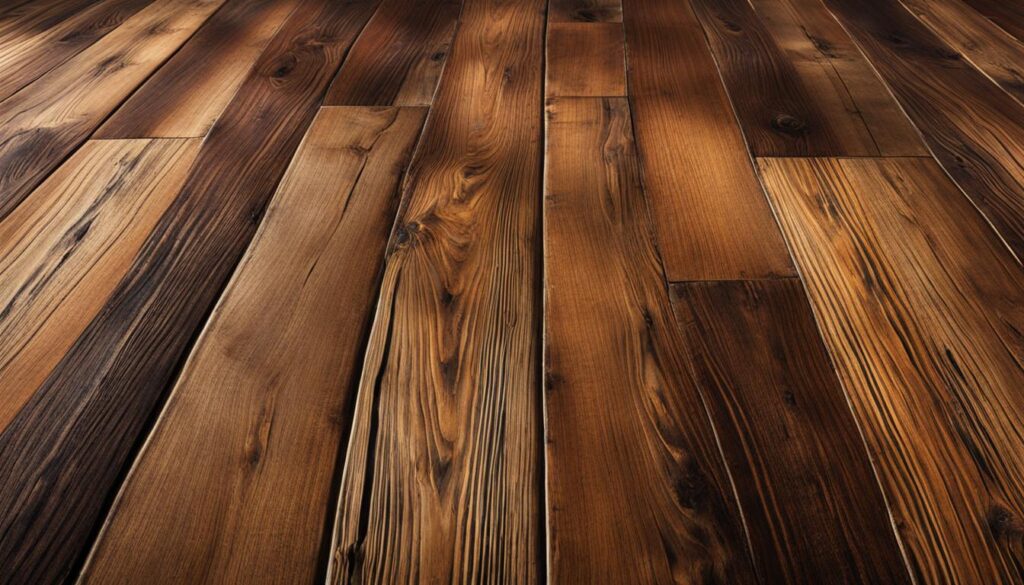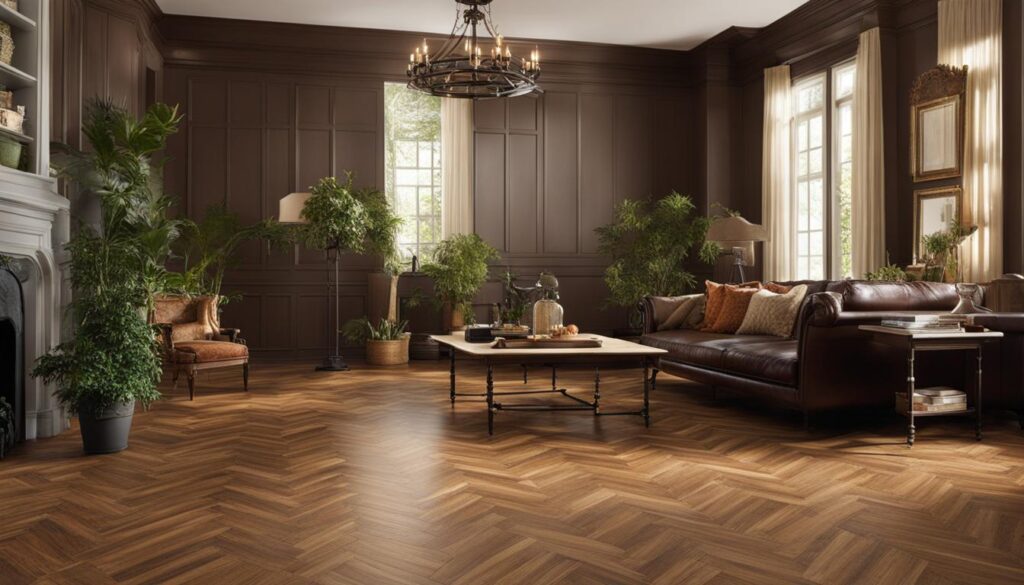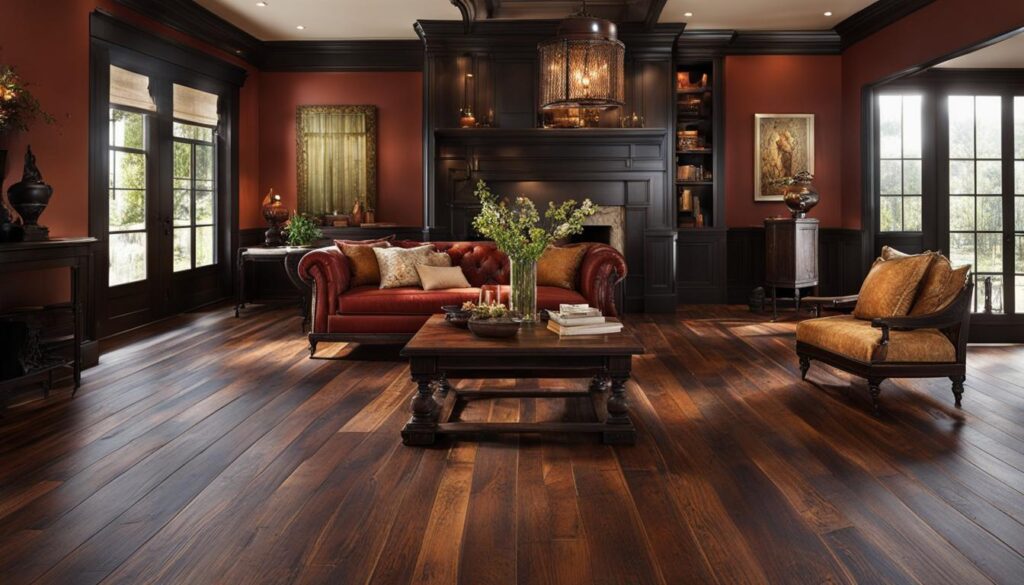Welcome to our guide on Eco-Friendly Flooring Options for Victorian Homes. Preserving history while embracing sustainability is a crucial aspect of creating beautiful and functional living spaces. Our guide will delve into the world of sustainable flooring options, exploring green flooring choices best suited for Victorian homes.
Key Takeaways
- Choosing eco-friendly flooring options ensures sustainability and preserves the charm and character of Victorian homes.
- There are several sustainable flooring options for victorian homes like hardwood, bamboo, cork, linoleum, and carpeting made from recycled materials.
- Eco-conscious renovation can reduce environmental impact and save money on energy bills in the long run.
- When choosing eco-friendly flooring, consider durability, maintenance, compatibility, and overall environmental impact.
- Make an informed decision and choose the right flooring option to create a beautiful and eco-conscious space.
Understanding the Importance of Eco-Conscious Flooring
At our company, we understand the significance of eco-conscious Victorian flooring. Choosing environmentally friendly floor coverings is essential for both the planet and maintaining your indoor air quality. Many traditional flooring options, like synthetic carpets and vinyl, can contain harmful chemicals that contribute to poor air quality and negatively impact the environment.
Opting for eco-friendly flooring options can benefit your Victorian home in multiple ways. Not only are they responsibly sourced and manufactured, but they also have lower VOC emissions that protect your home’s air quality. Additionally, environmentally friendly flooring is designed to last, reducing the need for frequent replacements that can contribute to environmental waste and harm.
By making conscious and informed choices when it comes to your flooring, you can make a positive impact on both your home and the planet. In the following sections, we will explore a range of sustainable flooring options that are perfect for eco-conscious Victorian homes.
Preserving the Historic Character with Sustainable Materials
When it comes to Victorian home renovations, preserving the historic character of your property is crucial. We understand that many homeowners want to keep the authenticity of their property, which is why we recommend sustainable flooring materials that can bring out the unique charm of your Victorian floors.
Some popular eco-friendly materials for Victorian floors are:
| Material | Description |
|---|---|
| Reclaimed Wood | Source: www.thespruce.com |
| Cork | Source: www.treehugger.com |
| Bamboo | Source: www.builddirect.com |
| Linoleum | Source: www.greenamerica.org |
These materials are not only sustainable but also bring a touch of history into your home. Reclaimed wood is a popular choice to maintain the original charm and unique character of your Victorian floors. Cork is an excellent eco-friendly option that is sound-absorbing and renewable, making it perfect for anyone looking for quality green materials. Bamboo features a highly renewable source and durability that’s great for a busy household. Linoleum is a natural material that offers durability, low maintenance, and high sustainability.
We encourage you to explore these materials and find inspiration for your ideal eco-friendly Victorian floors.
Best Flooring Choices for Eco-Conscious Renovations
When it comes to renovating your Victorian home with sustainability in mind, it’s crucial to select the best flooring choices. Not only do you want a durable option, but also one that minimizes the environmental impact. To help you make an informed decision, we’ve researched and compiled a list of eco-conscious renovation flooring for your Victorian home.
1. Hardwood Flooring
Hardwood flooring is a timeless choice that can add value to your home and last for decades with proper upkeep. Choose sustainable hardwood options like oak or maple, and look for Forest Stewardship Council (FSC) certification. FSC certification assures that the wood used has been harvested responsibly and sustainably sourced.
2. Cork Flooring
Cork is a renewable resource that comes from the bark of the cork oak tree. It’s durable, comfortable, and offers excellent insulation and soundproofing. Cork flooring is also antimicrobial, making it a great choice for allergy sufferers.
3. Reclaimed Wood Flooring
Reclaimed wood is a green choice that gives your flooring a unique look. It is sourced from various places such as old barns, factories, and warehouses. Choosing reclaimed wood flooring helps to reduce the demand for newly-sourced wood and prevents perfectly usable wood from going to landfill.
4. Bamboo Flooring
Bamboo is a rapidly renewable resource that can reach maturation in just four years. It’s highly durable and comes in a variety of shades and finishes to suit your aesthetic preference. Bamboo flooring is not only eco-friendly, but it’s also easy to maintain and hypoallergenic.
5. Linoleum Flooring
Linoleum, made from renewable materials like limestone, cork, and linseed oil, is an excellent choice for eco-conscious renovation flooring. It’s low maintenance, durable, and available in a wide array of colors. Linoleum flooring doesn’t emit harmful chemicals and is biodegradable.
6. Sustainable Carpeting
If you’re in need of a soft flooring option, sustainable carpeting made from recycled materials is a great choice. Choose carpet that is made with recycled fibers or look for products that have low VOC emissions. Bio-based carpeting, like wool or jute, is another sustainable option.
Now that you’re aware of the best eco-friendly flooring choices, you can make an informed decision when it comes to renovating your Victorian home. Consider your personal style and sustainability goals when choosing the perfect eco-conscious renovation flooring. It’s possible to have a beautiful and sustainable space without sacrificing durability or aesthetics.
Hardwood Flooring: A Timeless and Sustainable Option
Hardwood flooring is a classic choice for Victorian homes and it also happens to be a sustainable one. The durability and longevity of hardwood flooring make it an excellent investment for homeowners looking to reduce their environmental impact.
One of the most significant benefits of hardwood flooring is its renewable sourcing. Many hardwood flooring suppliers source their materials from responsibly managed forests that prioritize conservation and reforestation. Additionally, hardwood flooring is a long-lasting option, meaning it doesn’t need frequent replacement, further reducing its environmental impact.
Furthermore, the production process for hardwood flooring has a low carbon footprint. Compared to other flooring options, such as carpeting or vinyl, the production of hardwood flooring requires less energy and emits fewer greenhouse gases.
Another advantage of hardwood flooring is its timeless design. Hardwood floors are versatile and can complement a wide range of interior design styles. The natural texture and warmth of hardwood create a cozy and inviting atmosphere in any room.
If you’re considering hardwood flooring for your Victorian home, be sure to choose a reputable supplier that sources their materials sustainably. This ensures that your flooring not only looks beautiful but also aligns with your eco-friendly values.

Cork Flooring: A Renewable and Sound-Absorbing Solution
When it comes to sustainable flooring options, cork flooring should not be overlooked. Cork is derived from harvested cork oak trees, making it a renewable material that doesn’t harm the tree. The harvested bark grows back and is ready to be harvested again in about nine years.
Cork flooring is also durable and resilient, making it an ideal choice for high-traffic areas. Additionally, its natural texture provides excellent traction, making it a safe flooring option.
Another benefit of cork flooring is its sound-absorbing properties. The material’s air-filled pockets make it an excellent acoustic insulator, reducing noise transfer between floors. This property makes it a perfect sustainable flooring choice for Victorian homes, where noise reduction is key to maintaining the home’s peaceful atmosphere.
The Sustainable Benefits of Cork Flooring
| Benefits | Explanation |
|---|---|
| Renewable | Cork is a highly renewable material. The cork oak tree is not cut down during harvesting, and the bark is ready to be harvested again in about nine years. |
| Sound-absorbing | The air-filled pockets in cork flooring make it an exceptional sound insulator, reducing noise transfer between floors. |
| Durable | Cork flooring is resilient and can withstand heavy foot traffic without showing significant wear and tear. |
| Hypoallergenic | Cork’s anti-microbial properties make it naturally resistant to mold and mildew, making it an excellent choice for those with allergies or sensitivities. |
| Comfortable underfoot | Its natural texture provides excellent traction and is comfortable underfoot, making it a safe flooring option. |
| Low maintenance | Cork flooring requires minimal maintenance and can be easily cleaned with warm water and soap. |
When considering sustainable flooring options for your Victorian home, cork flooring is an excellent choice that offers both longevity and environmental benefits.
Reclaimed Wood: Embracing the Beauty of History
If you’re looking to add a touch of history and sustainability to your Victorian home, reclaimed wood flooring is an excellent option. Using reclaimed wood helps reduce the demand for new timber, a vital aspect of maintaining our planet’s forest health. Additionally, it offers unique aesthetics that can’t be found in modern timber flooring.
Reclaimed wood flooring is sourced from various places, including old buildings, barns and shipping containers. Whether as wide planks or small strips, each reclaimed wood plank has its unique history and character, from nicks and scratches to knots and nail holes, reflecting the past life of the timber.
Reclaimed wood flooring is not only sustainable but also durable. The reclaimed wood has been seasoned and has a natural patina that brings a charming warmth into your Victorian home. It has the strength, stability, and robustness of aged wood that simply can’t be matched by new timber. Moreover, reclaimed wood flooring requires minimal maintenance and is easy to clean, making it ideal for busy households.
At Eco-Friendly Flooring for Victorian Homes Guide, we prioritize sustainability and preserving historical elements.

If you’re considering reclaimed wood for your Victorian home, we recommend consulting with professionals and ensuring that the timber has been appropriately treated to remove any impurities. A professional can also help you choose a style that blends seamlessly with your home’s existing decor.
Advantages of Reclaimed Wood Flooring:
| Advantages | Description |
|---|---|
| Sustainability | Using reclaimed wood reduces the demand for new timber, promoting forest health and reducing carbon footprint. |
| Unique Aesthetics | Reclaimed wood flooring has a unique character and warmth that can’t be matched by modern timber flooring. |
| Durability | Reclaimed wood flooring has been seasoned and has a natural patina, making it strong, stable, and durable. |
| Low Maintenance | Reclaimed wood flooring requires minimal maintenance and is easy to clean. |
Bamboo Flooring: A Rapidly Renewable Resource
At our company, we understand the importance of sustainable flooring options for Victorian homes. Bamboo flooring is an excellent choice for those seeking a sustainable alternative to traditional hardwood. This is because bamboo is a rapidly renewable resource, which means it grows and matures much quicker than hardwood. Let us explore the benefits of bamboo flooring for your eco-conscious home renovation.
| Advantages of Bamboo Flooring | Disadvantages of Bamboo Flooring |
|---|---|
|
|
While bamboo flooring may not match traditional Victorian home aesthetics, it can seamlessly integrate with the historic charm of your home if you choose the right colour and style. However, if bamboo flooring isn’t the right choice for your home, we have other eco-friendly flooring options, such as hardwood, cork, reclaimed wood, linoleum, and sustainable carpets, which we can help you explore.
For more information about bamboo flooring and other sustainable flooring options for your Victorian home, contact us today to schedule an appointment with one of our flooring experts. We’ll help you make an informed decision and provide professional installation services.
Linoleum Flooring: Natural and Durable
For eco-conscious homeowners looking for sustainable flooring options, linoleum flooring is a fantastic choice. Made from natural materials like linseed oil, cork powder, and wood flour, linoleum is a renewable and biodegradable option that has been in use for over a century.
One of the key benefits of linoleum flooring is its durability. It’s built to withstand heavy foot traffic without showing signs of wear and tear, making it ideal for high-activity areas in Victorian homes. Additionally, because of its composition, linoleum flooring is naturally water-resistant, making it easy to clean and maintain.
Another advantage of linoleum flooring is its wide range of design options. It comes in various colours and patterns, making it easy to integrate into any decor scheme while maintaining a classic look and feel. This type of sustainable flooring also has anti-static properties that repel dirt, dust, and mold, perfect for homeowners with respiratory issues who require hygienic flooring.

Whether you’re updating an existing Victorian home or renovating a new one, linoleum flooring is a natural and durable option that ticks all the boxes for an eco-friendly floor. Its renewability, longevity, and low maintenance requirements make it an ideal option for sustainability-minded homeowners.
Sustainable Carpeting: Softness with a Low Environmental Impact
If you’re looking for a flooring option that provides a soft touch underfoot without compromising sustainability, sustainable carpeting is worth considering. In addition to being comfortable, sustainable carpets are environmentally friendly, making them an ideal choice for eco-conscious homeowners.
Sustainable carpeting is made from recycled materials, such as plastic bottles, and has a much lower environmental impact than traditional carpets. These types of carpets also emit low Volatile Organic Compounds (VOCs) which can improve indoor air quality and promote healthy living.
Moreover, sustainable carpeting is as durable and easy to maintain as traditional carpets, making them ideal for high traffic areas such as living rooms, stairs and bedrooms.
Why Choose Sustainable Carpeting?
Sustainable carpeting is an eco-friendly flooring option that combines comfort and sustainability. Choosing sustainable carpeting will help reduce environmental degradation and promote the use of renewable materials. Additionally, sustainable carpeting is often cheaper and of higher quality than traditional carpets, which means you can get a quality product that saves you money in the long run.
“Sustainable carpeting is much better for the environment and is a great way to reduce your carbon footprint while creating a cozy atmosphere in your home.”
Choosing the Right Eco-Friendly Flooring Option for Your Victorian Home
Now that we’ve explored a range of eco-friendly flooring options, it’s time to help you make the right choice for your Victorian home. There are several factors to consider when choosing eco-friendly flooring for historic homes.
- Durability: You want your new flooring to last for many years, so it’s essential to choose a durable option that can withstand heavy foot traffic and potential spills or stains. Hardwood, cork, and bamboo are all excellent choices for their resilience and longevity.
- Maintenance: Some eco-friendly flooring options, such as linoleum and sustainable carpets, require very little maintenance, making them ideal for homeowners who don’t want to spend a lot of time cleaning.
- Compatibility: It’s important to choose a flooring option that complements your home’s existing features and decor. Consider the colour, texture, and overall aesthetic of your home when selecting new flooring.
- Environmental impact: All the flooring options we’ve discussed in this guide are eco-friendly, but some may have a lower environmental impact than others. If sustainability is your top concern, consider options such as reclaimed wood or cork, which have the smallest carbon footprint.
Remember, choosing the right eco-friendly flooring for your Victorian home is essential for both the planet and your family’s health. With our guide, you can weigh the pros and cons of each option and make an informed decision that aligns with your values and lifestyle.
Eco-Friendly Flooring Comparison
| Flooring Type | Pros | Cons |
|---|---|---|
| Hardwood | Durable, long lifespan, renewable sourcing | Can be expensive, requires occasional refinishing |
| Cork | Renewable, sound-absorbing, durable | Can be dented or punctured, may require re-sealing every few years |
| Reclaimed Wood | Unique aesthetics, positive environmental impact | May require additional installation time, limited availability |
| Bamboo | Fast-growing, durable, seamlessly integrates with historic charm of Victorian homes | May contain formaldehyde, prone to scratches |
| Linoleum | Natural, durable, low maintenance | Can be prone to scratches and scuffs, may contain VOCs |
| Sustainable Carpeting | Soft underfoot, made from recycled materials, low VOC emissions | May require frequent cleaning, can be prone to stains |
Conclusion
In conclusion, we hope that this guide has provided you with useful insights into eco-friendly flooring options for your Victorian home. It’s becoming increasingly important to consider sustainability when updating your home, and by choosing green flooring choices, you can do your part for the planet while preserving the character of your historic property.
We discussed several sustainable flooring options suitable for Victorian homes. From the timeless beauty of hardwood to the sound-absorbing properties of cork, and the natural durability of linoleum, there are plenty of eco-friendly materials to choose from. And if you’re looking for something with a softer feel, sustainable carpeting is an ideal option.
When deciding on the right eco-friendly flooring for your historic home, it’s essential to consider factors such as durability, maintenance, and compatibility with your existing features. By doing so, you can ensure that your new flooring not only looks great but also stands the test of time.
So, whether you opt for hardwood, cork, reclaimed wood, bamboo, linoleum, or sustainable carpets, you can be confident that you’re making a positive impact on your home and the planet. Let’s work together to create a beautiful and sustainable future for all.
FAQ
What are the benefits of choosing eco-friendly flooring for Victorian homes?
Eco-friendly flooring options not only help reduce your carbon footprint but also promote better indoor air quality. They are a sustainable choice that preserves the historical integrity of your Victorian home while supporting the environment.
Can eco-conscious flooring options maintain the historic character of my Victorian home?
Yes, there are several eco-friendly materials that can preserve the historic charm of your Victorian floors. Reclaimed wood, cork, and bamboo flooring, for example, allow you to maintain the aesthetic while promoting sustainability.
Is hardwood flooring a sustainable option for Victorian homes?
Hardwood flooring is both timeless and sustainable. It has a long lifespan, can be sourced from renewable forests, and contributes to a low carbon footprint compared to other flooring materials.
What are the advantages of cork flooring for Victorian homes?
Cork flooring is a renewable material known for its resilience and sound-absorbing properties. It’s an eco-friendly choice that adds warmth and elegance to your Victorian home.
Why should I consider reclaimed wood flooring for my Victorian home?
Reclaimed wood flooring not only brings historical beauty into your home but also reduces the demand for new timber. It’s an eco-conscious option that combines sustainability with unique aesthetics.
Is bamboo flooring a sustainable alternative for Victorian homes?
Yes, bamboo flooring is an excellent sustainable alternative to traditional hardwood. Bamboo is a fast-growing resource that can be harvested in a renewable manner, making it ideal for eco-friendly Victorian homes.
What are the benefits of linoleum flooring for Victorian homes?
Linoleum flooring offers a natural and durable option for eco-friendly Victorian homes. It is composed of renewable materials, has a long lifespan, and requires minimal maintenance.
Can I find sustainable carpeting options for my Victorian home?
Yes, there are sustainable carpeting options available that prioritize eco-friendliness. These carpets are made from recycled materials and have low VOC emissions, reducing their environmental impact.
How do I choose the right eco-friendly flooring option for my Victorian home?
Consider factors such as durability, maintenance requirements, and compatibility with your home’s existing features. It’s important to find a flooring option that balances sustainability with practicality and aesthetics.
